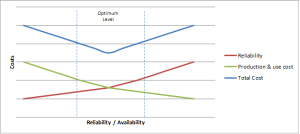Providing the right level of service to production will ensure the profitability of the business.
 Using a Business Needs Analysis will ensure that your maintenance program is on the same page as the goals of the business. Often times the two are not aligned, which leads to excess costs for the business, reducing the ability to be profitable. For example, does your operation require 99.9% reliability? It would be nice but that level of reliability is extremely difficult & costly to achieve. Think of the various industries that require that level of performance. NASA, the Armed Forces, Nuclear Power, etc. require 99.9% reliability and to achieve so, the effort in design and in operation is extremely intensive.
Using a Business Needs Analysis will ensure that your maintenance program is on the same page as the goals of the business. Often times the two are not aligned, which leads to excess costs for the business, reducing the ability to be profitable. For example, does your operation require 99.9% reliability? It would be nice but that level of reliability is extremely difficult & costly to achieve. Think of the various industries that require that level of performance. NASA, the Armed Forces, Nuclear Power, etc. require 99.9% reliability and to achieve so, the effort in design and in operation is extremely intensive.
They employ various engineering disciplines in all capacities, in all stages at a great cost. This is often cost prohibitive for most industries and is also not required. In most manufacturing operations there is an expected level of downtime that is built into the production plan and is acceptable. It is within this margin that the maintenance program must operate in. That is not to say that the business shouldn’t strive to do better and continue to improve, just that the maintenance program must be aligned with the business goals and evolve with them.
Determining the level of reliability that aligns with the business goals can be tricky, but can be done through a series of activities;
- Determine the business goals, which can usually be cascaded down to the plant level goals. For example, the goal may be to produce 10m widgets with a production cost of less than $5.40 per unit.
- Determine what level of performance is required by production to achieve the plant goals. This may be to operate at a minimum level of 80% OEE, with less than 5% overtime.
- Determine what maintenance needs to do to support the required level of production. Since the production goal is measured in OEE, maintenance may be required to maintain an equipment availability of 87.5%, while maintaining a maintenance budget of <$4m
- Implement plans to support the level of production through Maintenance & Reliability. These should be specific actions that will support the maintenance goals and may include;
- Ensure all equipment without severe consequences is maintained to a minimum level of care (clean, lubricate and meet all regulatory requirements) and no more.
- Review all remaining PMs for effectiveness.
- Maintain overtime to <10%
- Perform a RCA on all the top downtime each week to systematically eliminate the failures.
- Continue to evolve with the business goals. Seek to make small improvements over time to improve the performance of equipment and reduce costs. By staying ahead of the curve the maintenance function will support the current and future goals of the business.
Have you ever conducted a Business Needs Analysis or is your maintenance program based on trying to achieve 99% reliability? Do you overspend on various initiatives to achieve higher reliability than is required? If you have never conducted a Business Needs Analysis, take the time to do so and align your maintenance program with the business goals.
Remember, to find success, you must first solve the problem, then achieve the implementation of the solution, and finally sustain winning results.
I’m James Kovacevic
Eruditio, LLC
Where Education Meets Application
Follow @EruditioLLC

